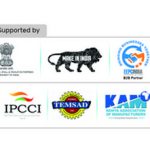
The German Textile and Fashion Industry
The German Textile and Fashion Industry is an important economic sector with an annual turnover of around 28 billion Euro and some 1.400 enterprises with 124.000 employees in Germany only. The biggest growth driver is technical textiles which are used in a wide range of high-tech products. The exceptional high export rate of more than 40 per cent reflects how valued German textile and fashion products are on the international market and emphasises the competitivity of German companies holding a leading position worldwide.
Germany remains the largest consumer market in Europe – in terms of both population size and purchasing power. The country also has the highest GDP in Europe with one of the highest total purchasing power.
With a population of 82.5 million (almost 16% of the EU-28 population), Germany remains the largest consumer market in Europe – in terms of both population size and purchasing power. The country also has the highest GDP in Europe (EUR 3,386 billion or almost 21% of EU-28 GDP), with one of the highest total purchasing power (EUR 1,893 billion).
The German population is affluent and current trends point to continued development and growth. German consumers are increasingly following individualistic value-for-money concepts. The typical German consumer is as equally receptive to discount retailers as to establish brand names across different product segments. As the largest consumer group with the greatest purchasing power, the generation of consumers aged 50+ is proving particularly attractive as a target group. Members of this group are healthier, more demanding and quality conscious than their parents were at the same age.
E-commerce, flexible hours and innovative sales services help boost demand. Modern and consumer-friendly structures support both volume business as well as niche suppliers alike.
Textiles, Garments and Shoes
The textiles, garments and shoes market in Germany is a close runner-up to the DIY and Home Improvement industry. German companies generating more than EUR 35 billion in turnover (of which about 60% textile, 40% clothing) which makes them the European leaders. This industry is made up of almost 1,400 mostly small and medium-sized businesses with a workforce of around 135,000. It has also transformed over the years into an increasingly innovative, high-tech sector. The German textile industry is a global market leader for technical textiles with a market share of 45%. Germany is also the fifth-largest exporter of clothing and textile products worldwide, and the second largest textile importer in the world next to the United States.
The clothing category comprises professional and protective clothing, in addition to fashion clothing and functional textiles. The annual turnover of the German clothing industry is around 12 billion Euros.
The home textiles segment includes bedding, curtain fabric, decorative fabric, upholstery fabric, carpet products, bathroom textiles, as well as lace and embroidery. German textile companies generate a revenue of approximately 3 billion Euros per year from home textiles.
The turnover from technical textiles by German producers is approximately 13 billion Euros per year. Textile companies are important suppliers to other sectors such as the automotive sector, the aerospace sector, the medical sector, geotechnics and many more.
Consumers in Germany have become increasingly environmentally conscious in recent decades, and companies able to manufacture sustainable and environmentally friendly products find themselves at a significant competitive advantage. Sixty percent of consumers in a recent study consider sustainability as being important to them when choosing a product or retailer. Forty-four percent of consumers are willing to pay a surcharge for sustainable packaging. This accounts more for the younger (more than 50 percent) than the older generation (30 percent).





